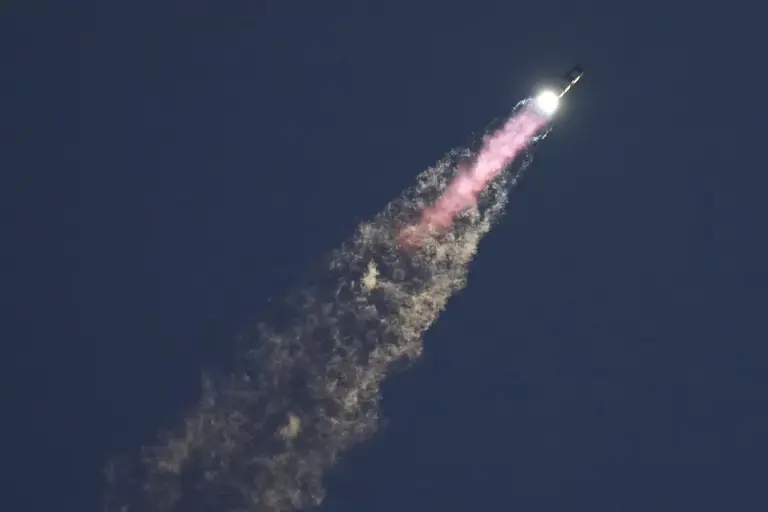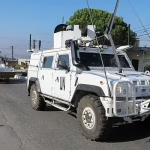The most potent rocket system ever built, Starship, was successfully launched on Sunday morning by SpaceX on its most recent test flight. Following its launch, a starship may eventually be used to transport people to the moon and Mars.
The Super Heavy rocket booster, topped by the unmanned Starship spacecraft, lifted off from SpaceX’s Starbase facility in Boca Chica, Texas, at exactly 8:25 a.m. ET (7:25 a.m. CT), during a 30-minute launch window that opened at 8 a.m. ET. This test flight featured an unprecedented attempt to manoeuvre the 232-foot-tall (71-meter) rocket booster to a massive landing structure after it separated from the upper Starship spaceship and burned through most of its fuel.
The Super Heavy was successfully captured in midair by SpaceX using two enormous metal pincers that they refer to as “chopsticks.”
However, the Starship spacecraft practiced a landing manoeuvre over the Indian Ocean while continuing to fly autonomously with its six onboard engines. The higher spacecraft is not expected to be recovered by SpaceX.
Determining how SpaceX might eventually recover and quickly re-fly Super Heavy rockets and Starship spacecraft for upcoming missions is the aim of each milestone. It is thought that SpaceX’s objective of significantly cutting the time and expense of transporting cargo or ships carrying people to Earth’s orbit and deep space depends on the prompt reuse of rocket elements.
As part of the Artemis III mission, SpaceX eventually intends to employ the Starship capsule as the landing vehicle that would transport NASA astronauts to the lunar surface as early as 2026. The business has federal contracts to finish the project that might total up to around $4 billion.
According to reports, SpaceX also intends to land the first humans on Mars with a Starship in the future. Pushing the boundaries, the development of starships has thus far revolved around a sequence of progressively intricate test flights, commencing in 2019 with short hop trials of a vehicle known as “Starhopper” that lifted just a few inches above the ground. The business has switched to more audacious launches of the Super Heavy rocket and fully stacked Starship capsule in recent times.
A combined test flight, which marked the first time a Starship and Super Heavy were tested together, began in April 2023. The 397-foot (121-meter) vehicle was the only target of that launch. And it succeeded in doing so before blowing up minutes later over the Gulf of Mexico.
Early in the construction of a spacecraft, SpaceX is known to welcome fiery mishaps, claiming that these setbacks enable the company to quickly implement design revisions that provide better outcomes. With every new launch, the corporation has set more ambitious aims. June saw the most recent test launch, which was the fourth in SpaceX’s integrated test flight campaign. Despite showing a severely burned and unstable wing during the webcast, the booster and spacecraft managed to survive re-entry into Earth’s atmosphere and successfully execute landing manoeuvres over the ocean, which was a major advancement. On October 13, the SpaceX Starship spacecraft passed over Earth into Mechazilla’s arms.
SpaceX pushed its testing even further by retrieving the Super Heavy booster post-launch. In the end, the tech company intends to retrieve and repurpose the Starship and Super Heavy spacecraft. However, figuring out booster recovery is still a logical first step given SpaceX’s wealth of knowledge in that field.
SpaceX has success landing rocket boosters after liftoff with the Falcon 9, a smaller workhorse rocket. After more than 330 launches, the rocket’s boosters have made soft landings on ground pads or maritime platforms, enabling the vehicles to be repaired and put back into service.
According to SpaceX, this has reduced expenses and enabled the business to undercut the other rocket manufacturers, but the starship is a significantly more sophisticated and potent system. At liftoff, the Super Heavy booster packs over ten times the thrust of the Falcon thanks to its 33 base engines, each more powerful than one of the nine engines on board.
In an attempt to expedite the Super Heavy’s return to Earth, SpaceX constructed a customized tower to support its landing rather than strapping landing legs, similar to those used on a Falcon 9 launcher, onto the spacecraft’s side.
Elon Musk, the CEO of SpaceX, gave the tower, which resembles a mechanical Godzilla, the nickname “Mechazilla” because of its enormous metal arms. The arms, often known as “chopsticks,” are intended to capture the spacecraft as they return to Earth in midair. They can be used to stack and shift boosters and spacecraft at the launch site prior to takeoff.
According to Musk, in the end, the chopstick arms will be able to just turn around and place a rocket back on the launchpad within.
In an interview on June 5, X boss stated that the vehicle can be refuelled within minutes of its return, potentially even as soon as thirty minutes after touchdown, the likelihood of Starship succeeding is an audacious plan.
He further stated that SpaceX is still working to figure out exactly how the catch operates. Musk said that while SpaceX’s goal for this voyage “sounds kind of insane,” it “has a decent chance of working” in a July interview that was uploaded to YouTube. He declared, “Success is one of the possible outcomes here because we’re not breaking physics.”
According to the company’s website, SpaceX received the Super Heavy rocket based on the need that “thousands of distinct vehicle and pad criteria are met,” which called for “healthy systems on the tower and booster as well as a manual order from the flight director of the mission.” Super Heavy would have made another attempt at its landing manoeuvre over the ocean if the attempt had been rejected. About seven minutes after launch, the Starship spacecraft attempted a controlled splashdown in the Indian Ocean, coasting for almost an hour.
Musk went on to say that one issue that Starship ran into on its fourth test flight in June was the disappearance of heat shield tiles, which are millions of tiny black hexagons attached to the spacecraft’s exterior and designed to protect it from extremely high temperatures during re-entry. According to Musk, the vehicle’s attempt at a smooth landing was severely hampered by the loss of a significant portion of those tiles.
“It was like trying to control it with little skeleton hands because of lost tiles,” Musk added, mentioning that the fourth flight touched down around 6.9 kilometres (9.7 miles) from its planned splashdown site in the ocean.
The intended splashdown point in the water was approximately 6 miles (9.7 km) away from where the fourth flight touched down. NASA Europa Clipper No. 3 LINKED PAGE NASA targets a “world that might be habitable today” in its sights. A “complete rework of its heatshield, with SpaceX technicians spending more than 12,000 hours replacing the entire thermal protection system with newer-generation tiles, a backup ablative layer, and additional protections between the flap structures,” is what the company claims to have done on its website. That might make Starship more resilient to the harsh realities of re-entry, sources disclosed.
The flight’s success might inspire the business to take on even more ambitious initiatives. For instance, SpaceX needs to work out how to refuel a Starship spacecraft in orbit. Such a move will be needed to provide the enormous vehicle with adequate propulsion to reach the moon. It might have prompted concerns about further delays for NASA’s moon aspirations if the business had fallen short of expectations or seriously damaged its launch facilities.
After the Apollo program concluded more than 50 years ago, NASA’s flagship human spaceflight program, Artemis, aims to land astronauts on the moon for the first time. The government space agency has already issued a warning that Starship’s development schedule would cause it to miss its 2026 target of making the first crewed lunar landing.




